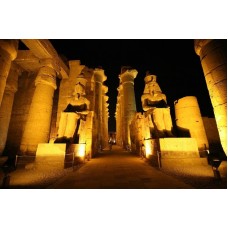Shopping Cart
0 item(s) - €0.00Luxor Temple & Luxor Museum
Availability: Out Of Stock
Ex Tax: €1.99
Luxor Temple & the Luxor Museum
The Temple of Luxor is among Egypt’s most beautiful Pharonic temples.
Always known as the Southern Shrine to distinguish it from the nearby Karnak Temple, it is located running north to south, parallel to the Nile in the centre of modern day Luxor.
Built upon the site of an earlier small Middle Kingdom temple, much of the present Temple of Luxor was constructed during the reign of the 18th Dynasty Pharaoh, Amenhotep III and completed under Ramses II who also added a large forecourt and the 24 meter high first pylon at the Temple entrance.
Flanking the gate of the first pylon are two seated colossi representing Pharaoh Ramses II, seated formally upon his throne dressed in the royal regalia.
The Temple’s scale is such, that it once housed a village within its confines and is unique among the principal Egyptian temple sites in having only two pharaohs leave their mark on its architectural structure. Asymmetric in design and measuring over 250 meters long, the temple complex was constructed in stages to a design comprising three separate axis with each wall, colonnade and hall rigorously aligned.
Over succeeding centuries several small shrines were added with the Temple Sanctuary containing the golden image of Amun Ra, rebuilt by Alexander the Great. Later, during the Christian era the temple’s inner court was converted into a church. By the time of the Arab conquest the temple was largely buried underneath accumulated river silt to the extent that the Mosque of Abu el Hagag was largely built over it, as can be seen today.
The audio also includes tracks detailing the nearby Luxor Museum, first opened in 1975. This contemporary museum contains artefacts that cover a period of over 4,000 years. Having largely evolved into a sculpture museum its most important exhibits today are the mud brick walls of the Temple of Akhenaton dating from the 14th century BC, a statue of the 18th Dynasty pharaoh, Thutmose III and a statue of Amenhotep III carved in pure black granite and coming from the temple of Medinet Habu on the West Bank.
Write a review
Your Name:Your Review: Note: HTML is not translated!
Rating: Bad Good
Enter the code in the box below:
www.itour-egypt.com © 2024





